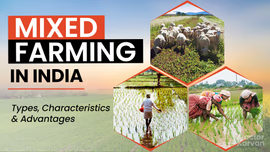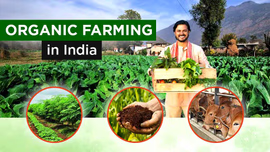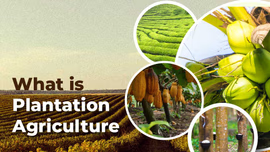Floriculture in India: A Sunrise Industry with Immense Profit Potential

Table of Contents
- Floriculture in India: Definition & Overview
- What are the Different Types of Floriculture in India?
- What are the Popular Floriculture Crops?
- How to Start a Floriculture Business in India?
- What is the Green House Technology for Floriculture?
- Government’s Initiatives for Floriculture
- Major Challenges in India’s Floriculture
- What is the Difference between Floriculture and Horticulture?
- Conclusion
Floriculture in India: Definition & Overview
Let us begin with understanding what is Floriculture – It is a branch of horticulture that involves cultivating, processing and marketing of ornamental plants. In simple terms, the growing of flowers is called floriculture. To put it another way, floriculture farming is the commercial cultivation of different varieties of flowers for various uses, including medicinal and ornamental ones.
According to the National Horticulture Database, the total floriculture production in 2023-24 was 2284 thousand tonnes loose flowers and 947 thousand tonnes cut flowers, and the total area under floriculture cultivation was 285 thousand hectares.
The major states practising floriculture on a large scale are Maharashtra, Gujarat, Assam, Uttar Pradesh, Madhya Pradesh, Karnataka and Tamil Nadu. Madhya Pradesh, Tamil Nadu, Andhra Pradesh and Karnataka account for over 50% of floriculture products in India.
India’s Floriculture Exports Market
India exported around 20,000 MT of floriculture products and earned Rs. 718 Crores (86.7 million USD) in 2023-24. The major countries that import the floriculture products from India are the USA, United Arab Emirates, United Kingdom, Malaysia, Germany and the Netherlands. During 2023-24, India stood at USD 121.39 Million, in terms of the export of fruits and vegetable seeds.
India has an excellent geographic and strategic location near big flower markets like East Asia and Europe. The Indian government has given the floriculture industry a 100% export-oriented status. Several export-oriented units have been set up to offer facilities like reefer vans, pre-cooling chambers and cold stores. APEDA, or Agricultural and Processed Food Products Export Development Authority, oversees Indian floriculture and its components, such as promotion, development and export.
What are the Different Types of Floriculture in India?

The main types of floriculture include cut flowers, loose flowers, potted plants, nurseries and perfumes. These floriculture types are discussed below:
|
Types of Floriculture |
Uses |
Examples |
|
Cut Flowers |
Ceremonies, decorations, floral baskets and bouquets. |
Orchids, roses, carnations, lily and tulips. |
|
Loose Flowers |
hair ornaments and floral jewellery, rangoli arrangements, religious offerings, garlands and bouquets. |
Kaner, jasmine, marigold and rose. |
|
Potted Plants |
Indoor and outdoor decorations sites such as hotels, corporate offices, homes and malls. |
Money plants, ferns and maranta. |
|
Nursery |
Seedlings, fully-grown plants and flowers. |
Sunflowers, marigolds, jasmines and roses. |
|
Perfumes |
Floral extracts, essential oils, etc. |
Tuberose, kewra, jasmine and rose. |
What are the Popular Floriculture Crops?
There are a variety of floriculture crops in Indian market. The most popular floriculture crops are discussed below:
Rose
Rose is the leading flower in the floriculture sector in India. It is used as cut flowers, bouquets and garden plants. It is also used in the making of essential oils, gulkand like processed food and rose water. Rose flowers have different sizes, shapes and colours from red to white and more. The different types of roses in India are hybrid tea rose, grandiflora rose, floribunda rose, etc. The major rose growing states in India are Karnataka, Tamil Nadu, Maharashtra, Bihar, Uttar Pradesh and West Bengal.
Marigold
Marigold is the most common grown flower in India used in the garden decorations and extensively used as loose flowers for making garlands. It is a popular floriculture crop due to its rapid growth and low investment. It is a short duration crop and has an attractive shape and vibrant colour. It is mostly used during the festivals like Dussehra and Diwali. Maharashtra, Karnataka, Gujarat and Andhra Pradesh are the major states of marigold flower in India.
Carnations
Carnation is the second leading crop which is mostly preferred for commercial purposes due to its keeping quality, wide range of colours, withstand in long distance transportation and remarkable quality to rehydrate. It is an important cut flower crop cultivated all over the globe. It has a wide range of colours including yellow, pink, lavender, white, etc. In India, it is grown in Himachal Pradesh, Punjab, West Bengal, Jammu and Kashmir and Karnataka.
Tulip
Tulip is the most popular garden flower due to its appearance and vibrant colours. It is an egg or cup shaped flower with six petals. It comes in various colours like orange, pink, cherry, magenta, salmon, crimson, purple, etc. Tulips are excellent for cut flowers, beds, pots and are grown in the open as well as under protected conditions like polyhouses. These are majorly grown in Jammu & Kashmir and Himachal Pradesh.
Orchids
Orchids are exotic flowers with a wide range of bright colours ranging from red, purple, violet, yellow, pink and white. It is the most selling flower in Indian cut flower industry. It is mostly used for two purposes in India – as cut flowers for decoration purpose for special occasion or festivals, offices and potted plants for its aesthetic values in houses and gardens. These are also used for herbal medicines and food beverages. Arunachal Pradesh, Assam and Sikkim are the major orchid producing states of India.
How to Start a Floriculture Business in India?
- Step 1: The first and foremost step in starting a floriculture business is market research. Identify your buyers with the proper insight on this topic.
- Step 2: Next, choose which type of flower product you want to cultivate and sell.
- Step 3: Find the right location and infrastructure for your cultivation where the climate is appropriate and quality water and soil are available.
- Step 4: Select good-quality seeds for better yields. So, always consider the varieties, diseases, etc.
- Step 5: Use irrigation methods such as drip irrigation and mulching to optimize resources and cost.
- Step 6: The most important step is the marketing of the flower products. Consider competitive pricing based on the market selected for sale, good-quality packaging, and value-added services for your buyers.
What is the Green House Technology for Floriculture?
Using greenhouses for the protected cultivation of cut flowers is gaining popularity in India. Greenhouse farming involves constructing a structure called a greenhouse, which is covered by plastic film or glass. It not only offers ideal growth conditions for flowers but also uses resources like water and land efficiently. It also promotes all year-round flowers which results in increased yield.
Commercial floriculture is done using controlled climatic conditions as a hi-tech activity in a greenhouse. Farmers regulate several factors like humidity, temperature and sunlight exposure to obtain quality floriculture products. A greenhouse can be low-cost, medium-cost, or high-tech based on the technology used, construction cost, and greenhouse material used.
Government’s Initiatives for Floriculture
The Indian government has taken several steps to promote floriculture farming. Some of the initiatives taken by government are:
Mission for Integrated Development of Horticulture (MIDH): This primary Centrally Sponsored Scheme aims to achieve the overall growth of the horticulture sector and covers aromatic plants and flowers. The financial assistance for a maximum of 2 hectares per beneficiary under MIDH is as follows:
- Cut flowers: Rs. 1 lakh per hectare
- Bulbous flowers: Rs. 1.50 lakhs per hectare
- Loose Flowers: Rs. 40,000 per hectare
Agricultural and Processed Food Products Export Development Authority (APEDA): Agricultural and Processed Food Products Export Development Authority (APEDA) is responsible for export promotion and development of floriculture in India.
Council of Scientific & Industrial Research (CSIR) Floriculture Mission: This floriculture mission is being implemented in 22 states to enhance the income of farmers and develop entrepreneurship through high value floriculture utilizing CSIR technologies.
Major Challenges in India’s Floriculture
Floriculture is an important industry in India from economic, social, and aesthetic perspectives. It can generate more job opportunities and higher foreign exchange earnings. But there are some challenges faced in this sector:
- Smaller Land Holdings: usually floriculture farmers have a very small land holding that becomes an obstacle for them to invest in large-scale, modern cultivation practices.
- Lack of Knowledge: As this is not a very old concept so there are limited resources that help guide on the high yield varieties, soil testing and proper doses of pesticides and fertilizers.
- Unavailability of Skilled Labour: The unavailability of skilled workers for plant protection, harvesting and post harvesting of floriculture produce is another challenge.
- Climatic Changes: Climate changes like excessive heat, cold, continuous rainfall, etc. leads a great impact on flowers in commercial production under open field conditions.
- Unavailability of Market & Transport: Non availability of market, difficulties in transportation due to high perishable produce, delayed in payment after sell of flowers, inadequate arrangements for grading and storage, etc. are becoming obstacle in the floriculture business.
What is the Difference between Floriculture and Horticulture?
|
Floriculture |
Horticulture |
|
Floriculture is the process of growing and marketing flowers. |
It deals with growing and managing different varieties of plants. Floriculture is sub-branch of Horticulture. |
|
It involves the cultivation of foliage plants and flowers for commercial purposes. |
It involves the cultivation of fruits, vegetables, ornamental plants, flowers etc. |
|
Popular crops cultivated under floriculture are roses, marigolds, tulips, lilies, etc. |
Popular crops cultivated in horticulture are bananas, carrots, mushrooms, cashews, geranium, zucchini etc. |
Conclusion
India’s floriculture sector has seen a significant growth over the years, which is contributing to the country’s agriculture and generating employment opportunities. Also, the demand for floriculture products is growing in international markets. Thus, it is the right time to take up floriculture and earn more by growing flowers for export purposes. Factors like urbanization, changing lifestyles and the rise in e-commerce are making more people buy floriculture products. India has a huge opportunity to meet this demand and increase foreign exchange earnings. Some more agro export zone should be introduced by the Govt. of India for promoting export of floriculture.
Also, flowers are a visual feast and thus are used widely for decorative purposes in homes and offices. They are also important from a social point of view as they are used on several occasions, such as marriage ceremonies and birthday parties. Moreover, the flower processing industry also plays great role with products like extraction of oil, pigments, production of dry flowers. So, the use of floriculture products is expected to increase in coming years as well, creating a positive impact on the floriculture industry.
Frequently Asked Questions On Floriculture in India: A Sunrise Industry with Immense Profit Potential
1. What is the definition of floriculture?
Floriculture is defined as the science of cultivating different foliage plants and flowers for commercial purposes.
2. Why Floriculture is so important in India?
Floriculture is important in India because of its economic value and social and aesthetic perspective.
3. What are the popular floriculture crops?
Rose, marigolds, carnations, and tulips are some of the popular floriculture crops.
4. What are the Different Types of Floriculture in India?
The main types of floriculture include cut flowers, loose flowers, potted plants, nurseries and perfumes.


Related Blogs












